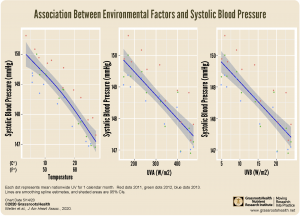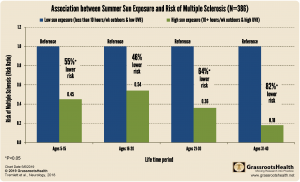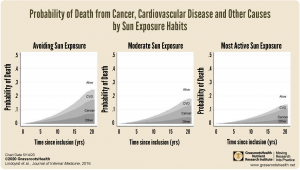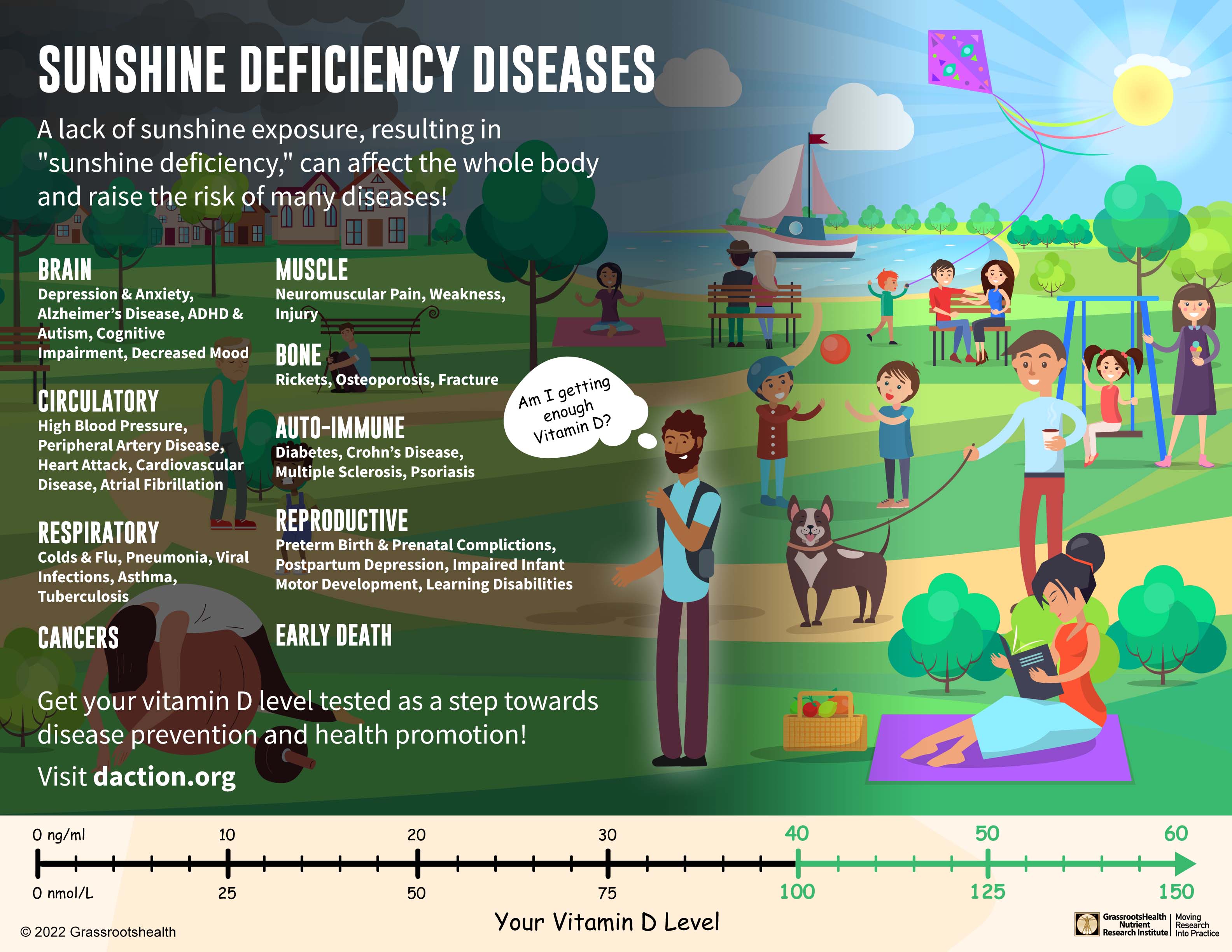Diseases Related to “Sunshine Deficiency”

From GrassrootsHealth
A lack of sunshine exposure can lead to decreased health and an increased risk of many diseases, also known as “Sunshine Deficiency” diseases
Key Points
- 340,000 deaths per year in the United States and 480,000 deaths per year in Europe, as well as a rise in many diseases, could be attributed to insufficient sun exposure or “sunshine deficiency.” These diseases include cancer (especially breast and colon cancer), hypertension, cardiovascular disease, metabolic syndrome, multiple sclerosis (MS), Alzheimer’s disease, autism, asthma, type 1 diabetes, and myopia.
- One group of researchers has reported that the mortality rate for women who avoided sun exposure was two times higher than those with the highest sun exposure, and that avoidance of sunshine resulted in a shorter life expectancy comparable to the shortened life expectancy of smokers
- Increased sun exposure was has been related to increased whole brain volume and increased grey matter, even after adjusting for vitamin D level, indicating that sun exposure, not just vitamin D from sun exposure, may be a direct contributing factor to brain health and MS diagnosis and progression
Sensible sunshine exposure has been shown to have a positive impact on health and can help protect against many diseases, helping people live longer. The known health risks associated with low vitamin D levels and lack of sun exposure are summarized by researchers such as Hoel and De Gruijl, who conclude that moderate UV exposure from the sun, without burning, is a health benefit and should be recommended as such. Unfortunately, modern lifestyles keep many indoors and out of midday sunshine most days of the year, causing them to experience “sunshine deficiency” and increasing their risk of many diseases.
Sunshine Avoidance Can Lead to an Early Death
A 2014 study of 29,518 Swedish women by Lindqvist et al. found that all-cause mortality was inversely related to sun exposure. The mortality rate for women who avoided sun exposure was two times higher than those with the highest sun exposure, with an intermediate mortality rate in those with moderate sun exposure.
In a following 2016 analysis of the same group of women, Lindqvist et al. found that avoidance of sunshine resulted in a shorter life expectancy comparable to the shortened life expectancy of smokers. Compared to those with the highest sun exposure, life expectancy for women who avoided sun was shorter by 0.6 to 2.1 years.
The lead author, Dr. Pelle Lindqvist, put it another way,
“We found smokers in the highest sun exposure group were at a similar risk as non-smokers avoiding sun exposure, indicating avoidance of sun exposure to be a risk factor of the same magnitude as smoking.”
Hot off the Press! A new (2024) study by Stevenson et al. involving 395,000 individuals found that individuals living in areas with more sunlight or who regularly used solariums had lower risks of all cause, cancer, and CVD mortality. More specifically, solarium users had a 15% lower risk of all-cause mortality, a 23% lower risk of cardio-vascular disease mortality, a 14% lower risk of cancer mortality, and a 12% lower risk of non-CVD/non-cancer mortality as compared to solarium non-users.
A 2020 review of studies on the health effects of sunshine by Alfredsson et al. indicated that 340,000 deaths per year in the United States and 480,000 deaths per year in Europe, as well as a rise in many diseases, could be attributed to insufficient sun exposure or “sunshine deficiency.” These diseases include cancer (especially breast and colon cancer), hypertension, cardiovascular disease, metabolic syndrome, multiple sclerosis (MS), Alzheimer’s disease, autism, asthma, type 1 diabetes, and myopia.
The infographic below illustrates some of the different diseases affected by a lack of sunshine and vitamin D.
Click to Download, Print & Share
While health concerns resulting from sunshine deficiency may be due to deficiency of vitamin D from lack of UVB exposure, they could also be attributed to an inefficient release of nitric oxide from sun exposure and other physiological benefits from the sun and its wide range of solar radiation.
The following is a breakdown of research linking several health conditions to “sunshine deficiency.”
Sunshine Exposure Reduces the Risk of Many Diseases
Decreased Cancer Risk
Research over the last few decades have confirmed a significant relationship between increased lifetime sunshine and UVB exposure and a decreased risk of many different types of cancer. In fact, a 2022 review by Munoz and Grant found that solar radiation was associated with a reduced incidence of 23 different types of cancer. Their study also suggested that reaching a vitamin D level of 80 ng/ml (200 nmol/L) could reduce cancer incidence by approximately 70% compared to vitamin D levels of 10 ng/ml (25 nmol/L).
The relationship between sunshine exposure and cancer risk was reviewed in detail in a previous Sunshine Month post here.
Lower Risk of Cardiovascular Disease, Heart Attack, and Hypertension
 Research suggests that avoidance or lack of sunshine may be a risk factor for increased blood pressure and death from heart attacks. A study by Lindqvist et al. looked at data from 23,593 women and found that, compared to those with the greatest amount of sun exposure, women with low sun exposure habits had a 41% higher risk of hypertension, and women with moderate sun exposure habits had a 15% higher risk.
Research suggests that avoidance or lack of sunshine may be a risk factor for increased blood pressure and death from heart attacks. A study by Lindqvist et al. looked at data from 23,593 women and found that, compared to those with the greatest amount of sun exposure, women with low sun exposure habits had a 41% higher risk of hypertension, and women with moderate sun exposure habits had a 15% higher risk.
A study published by Weller et al. in 2020 tested if environmental UV exposure had an effect on systolic blood pressure in a cohort of over 340,000 chronic hemodialysis patients and found that temperature, UVA, and UVB light were all inversely related to systolic blood pressure. In addition, the authors found that pre-dialysis systolic blood pressure varied by season and was approximately 4 mm Hg higher in black patients than white patients. The results of this study raise the concern that insufficient sun exposure may be a risk factor for hypertension in the general population, and even more so for the black population.
Another study from Harvey et al. found that the incidence of death from heart attack in Sweden between 1987 and 2009 varied by season and latitude. (The range of latitude in Sweden is from 55-69°N.) For men, every 1° of latitude northwards corresponded with a 1.3% increase in death related to heart attacks; for women, a 0.6% increase. Additionally, the incidence of death from heart attacks was highest in the winter months and lowest in the summer months.
Reduced Risk of Cognitive Impairment
A study by Gao et al. looked at data from 1192 participants aged 60 years and older and residing in rural China who provided information about their long-term sun exposure behaviors including time of day when outdoors, duration outdoors, and use of sun protection. The research team used the Mini-Mental State Examination (MMSE; maximum score of 30) to assess participant’s orientation, memory, language, calculation, and attention. They found that participants in the high sun exposure group had higher average mental state scores of cognitive function compared to participants in the medium or low exposure groups. This study concluded that long-term high sun exposure throughout life could reduce the risk of cognitive impairment in the later years of life.
Reduced Risk of Depression and Suicide
Hot off the Press! A new (2025) study by Tanaka and Matsubayashi examined how sunlight exposure influences mental health outcomes, particularly suicide. The researchers used comprehensive U.S. county-level data to identify causal effects of sunlight by leveraging exogenous variations in solar insolation (sunlight energy) due to weather and geographic factors.
They discovered that a one standard deviation reduction in sunlight in a given month compared to the prior month leads to a 6.76% increase in suicide rates. This effect appears robust across different model specifications, geographic areas, and population subgroups. The authors propose that the mechanism linking sunlight to suicide operates through depressive symptoms—with reduced sunlight likely contributing to greater severity or prevalence of depression, which in turn elevates suicide risk. This aligns with existing medical literature indicating that sunlight exposure influences biological rhythms, serotonin levels, and mood regulation—factors intimately connected with depression.
This new study provides strong empirical evidence that diminished sunlight exposure significantly increases suicide risk, reinforcing the idea that environmental light is a key determinant of mental health. The results suggest public health interventions could consider environmental and seasonal factors in suicide prevention strategies.
Decreased Risk of Multiple Sclerosis (MS)
 Results from Tremlett et al. from the Nurses’ Health Study found that people living in high UVB areas before the onset of MS had a 45% lower risk of MS compared to those living in low UVB areas, and those who spent 10 or more hours per week outdoors in the summer in high UVB areas during ages 31-40 had an 82% lower risk of MS compared to those who spent less than 10 hours per week outdoors in low UVB areas. Other age groups also showed a decreased risk.
Results from Tremlett et al. from the Nurses’ Health Study found that people living in high UVB areas before the onset of MS had a 45% lower risk of MS compared to those living in low UVB areas, and those who spent 10 or more hours per week outdoors in the summer in high UVB areas during ages 31-40 had an 82% lower risk of MS compared to those who spent less than 10 hours per week outdoors in low UVB areas. Other age groups also showed a decreased risk.
Another study by Gallagher et al. examined whether higher levels of ambient UV exposure were associated with a lower risk of MS among almost 40,000 radiologic technologists. The researchers found that those with the highest lifetime UV exposure in the winter had an almost 50% lower risk of MS compared to those with the lowest. Sebastian et al. found that children who spent more time outdoors in the summer sunshine had a decreased risk of developing MS compared to those who spent less than 30 minutes outdoors in the summer sunshine, with evidence of a dose-response relationship. These authors concluded “If this is a causal association, spending more time in the sun during summer may be strongly protective against developing paediatric MS, as well as residing in a sunnier location.”
Zivadinov et al. found that increased sun exposure was also related to increased whole brain volume and increased grey matter, even after adjusting for vitamin D level. This indicates that sun exposure, not just vitamin D from sun exposure, may be a direct contributing factor to brain health and MS diagnosis and progression.
A 2020 study by Hedström et al. provided further evidence that low sun exposure increased the risk for MS. Results indicated both a direct effect of sunlight exposure as well as an indirect effect, through the synthesis of vitamin D, on the risk of MS. These findings support the relevance of sunshine exposure and its effect on vitamin D status, both together and separately, for the prevention of MS, and are especially relevant for those with a genetic predisposition to MS.
Diabetes Incidence is Associated with Latitude
 Studies have shown an association between UV exposure, vitamin D, nitric oxide, and the suppression of metabolic syndrome and diabetes development. In fact, higher rates of type 1 diabetes and several cancers are observed in the far northern and southern latitudes – locations that have lower UVB irradiance from the sun.
Studies have shown an association between UV exposure, vitamin D, nitric oxide, and the suppression of metabolic syndrome and diabetes development. In fact, higher rates of type 1 diabetes and several cancers are observed in the far northern and southern latitudes – locations that have lower UVB irradiance from the sun.
In this video, Edward Gorham, PhD, describes the prevalence of vitamin D deficiency in terms of sun avoidance and person, place, and time. He identifies key items of evidence suggesting a protective association between sunlight, vitamin D, and risk of type 1 diabetes.
Findings from Habets et al. (2023) showed that blood glucose levels were normal for longer among subjects when they were exposed to natural light compared to when they were exposed to artificial light throughout the day (59% vs 51% of the time). Additionally, participants were better able to metabolize fat as an energy source over carbohydrates when being exposed to natural light. This study demonstrates that exposure to sunlight could help treat and prevent type 2 diabetes by improving metabolism and blood sugar control.
Improved Immune Health and Lower Risk of Viral Infections
The incidence of infectious disease has been related to several factors, including season, temperature, humidity, and UV radiation, with certain respiratory illnesses such as the flu being especially known to increase during specific months or seasons. Some studies have also revealed a beneficial association between higher ambient UV levels and lower rates of COVID-19 deaths. A study of the 1918 flu found a general trend with lower rates of pneumonia as a complication of influenza and influenza fatalities for those locations at lower latitudes within the United States.
Asthma, Lung Development, and Eczema
While research has shown a relationship between vitamin D levels and asthma, some studies mentioned by Alfredsson et al. indicate a positive correlation between an increased incidence of asthma and latitude and an association between the lung development of newborns and UV exposure of the mother. Other findings include a reduction of about 50% in the development of eczema among children exposed to higher doses of UV radiation.
Reduced Risk of Inflammatory Bowel Disease (IBD)
A 2019 study by Holmes et al. assessed the association between sun exposure and IBD among children aged 0-17 years included 99 IBD patients and 396 controls (children without IBD). The research team found a 6% reduced risk of IBD for every 10 minutes sun exposure in the previous summer or winter. The association was stronger as age increased indicating a long-term, cumulative effect.
Improved Infant Motor Development and Postpartum Depression
A study by Zhang et al. found that infants receiving vitamin D (400 IU/day) plus sunlight had better motor development scores and lower cortisol levels over the next two months compared to infants only taking vitamin D supplements (400 or 1000 IU/day) or the control group. Infants in the highest sun exposure group (7-14 hours/week) achieved the best scores and had the lowest cortisol levels.
Further, mothers who received sunlight exposure had improved depression scores and lower cortisol levels compared to mothers who did not receive sunlight exposure. These findings indicate that sunlight and vitamin D supplements combined can improve motor development, lower cortisol levels, and improve depressive symptoms.
Lower Risk of Childhood Learning Disabilities with Prenatal Sunshine Exposure
In a study by Hastie et al. of 422,512 Scottish schoolchildren, 79,616 (18.8%) had learning disabilities. Maternal records of total hours spent in the sun and total ultraviolet radiation (UV) exposure during pregnancy were collected and analyzed. Results showed a strong inverse relationship between time spent in the sun during pregnancy and the prevalence of learning disabilities in offspring. Children of women with the most sunshine and UVB exposure during pregnancy had the lowest risk of learning disabilities, whereas children of women with the lowest sunshine and UVB exposure during pregnancy had the highest risk. This study indicates a dose-response relationship between maternal sun exposure during pregnancy and incidence of learning disabilities in their children. This means that more sunshine exposure during pregnancy, specifically UVB light, is associated with a lower risk of learning disabilities in children.
First Trimester Sunshine Exposure and Reduce Risk of Preterm Birth
A study by Megaw et al. looked at the connection between available sunshine exposure and preterm birth among women in Scotland. The authors found that the more sunshine exposure available to pregnant women during the first trimester of pregnancy, the lower the rate of preterm birth. There was even evidence of a dose-response association, where the women with the highest amount of sun exposure had an even greater risk reduction in preterm birth than the women with the least amount of sun exposure. The study did not find an association between preterm birth risk and available sunshine exposure during the second trimester.
Lower Risk of Generalized Anxiety Disorder
Limited or minimized sunshine exposure has also been associated with and increased risk of generalized anxiety disorder (GAD). A 2022 study by Al Anouti et al. found such an association among female college students who practiced more sun avoidance habits that minimized their exposure to sunshine; in fact, the score used to assess sun exposure habits was a strong predictor of GAD status. The risk of GAD was also increased among women with a low dietary intake of vitamin D, and those with a history of vitamin D deficiency.
Better Mood
A study by Toledo et al. looked at whole-body exposure to narrow-band UVB and its impact on mood, as well as resulting levels of vitamin D, interleukin-6 (IL-6), cortisol, and beta-endorphins (B-END). Mood was scored based on satisfaction, tiredness, wellbeing and irritation, with higher scores representing worse moods. Participants experienced significant improvements in mood over the five days following NB UVB exposure. Both vitamin D and cortisol levels were correlated with the baseline mood state, and from beginning to end of the study, vitamin D levels increased while IL-6 levels decreased.
Improvement in Skin Disorders
Phototherapy has a history of being especially useful for treatment of skin disorders like cutaneous tuberculosis, eczema, and psoriasis. Niels Ryberg Finsen, the founder of modern dermatological phototherapy, won the Nobel Prize in Medicine for his discovery of phototherapy treatment for lupus vulgaris (the skin manifestation of tuberculosis) by using concentrated light rays. Finsen’s work also led to other developments in phototherapy, such as heliotherapy, which consists of a patient gradually being exposed to sunlight until they become acclimated to local sun conditions.
Reduced Risk of Melanoma
Regular, moderate sunshine exposure and higher levels of vitamin D are shown to decrease (not increase) the risk of melanoma. A comprehensive review by Gandini et al. on sun exposure and melanoma found a positive association between intermittent, high intensity sun exposure and increased risk for melanoma and an inverse association between high occupational sun exposure and risk for melanoma. In other words, chronic sun exposure, such as that among outdoor workers, reduced the risk of melanoma.
Additional Health Benefits of Sunshine Exposure
Additional health benefits of sunshine exposure are provided by Dr. William Grant, in his blog “The Health Benefits and Risks from Moderate Sun Exposure.”
SmartTan.com news articles regularly report medical and scientific information to keep you abreast of current events related to UV light. This information is not intended to be used by any party to make unwarranted health claims to promote sunbed usage. Indoor tanning businesses are obligated to communicate a fair and balanced message to all clients about your products and services including the potential risks associated with indoor tanning. Contact your Smart Tan representative to find out more about what you can and can’t say in your tanning salon business.
© 2025 International Smart Tan Network. All rights reserved.


